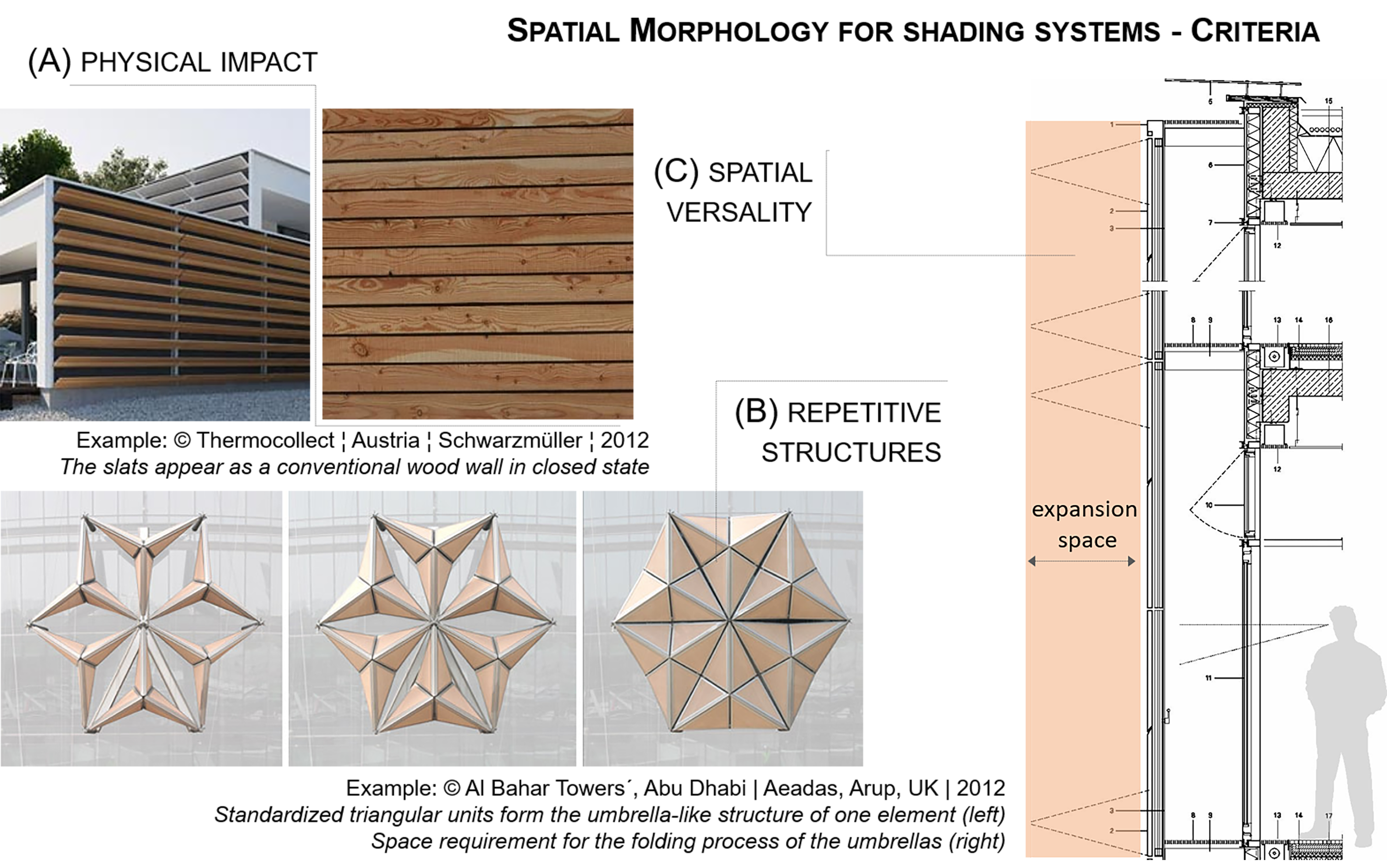Downloads
DOI:
https://doi.org/10.7480/jfde.2018.3.2574Keywords:
adaptive facades, shading systems, biomimetics, geometry, growth pattern, kinetic mechanisms, spatial morphologyAbstract
Dynamic shading systems represent the majority of realised adaptive façades. It seems that geometrically complex kinetic solutions have increased in recent years, mainly due to the use of parametric design tools and digital production. In most shading systems, however, geometry rarely plays a guiding role in the design. The kinetic mechanisms are confined to linear or planar geometries. Geometry plays an important role in biological organisms, because it is the decisive factor for efficiency and growth. Their growth patterns could provide new insights for dynamic shading designs. For this, spatial morphology criteria for shading systems were identified to obtain criteria directly related to geometry. These were supplemented by criteria on kinetic mechanisms. Then, biological analogies that correlate geometrical structures with adaptability were sought. Using biomimetic methods, particularly from functional morphology, principles in growth patterns were analysed and compared to shading systems. It revealed that the restriction to space, location, and material-inherent properties does not affect the solution diversity, but follows an evolutionary objective: Plants, for example, use ingenious geometrical structures to allow adaptation, mainly over lifetime but also dynamically. Whether these principles can be applied to the design of dynamic shading systems is then discussed. The aim of the paper is to provide impulses for further studies on adaptive shading systems that focus on the innovative use of space with greater flexibility in motion. The overall premise of the paper is to demonstrate the applicability of biomimetic methods for architectural engineering.
How to Cite
Published
Issue
Section
License
Copyright (c) 2018 Susanne Gosztonyi

This work is licensed under a Creative Commons Attribution 4.0 International License.
Authors or their institutions retain copyright to their publications without restrictions.
References
Aelenei, D., Aelenei, L., & Vieira, C. P. (2016). Adaptive Façade: concept, applications, research questions . Energy Procedia 91, pp.269-275.
Allaby, M. (2018). Gloger’s rule. Retrieved from Oxford Reference - A Dictionary of Zoology. Retrieved from http://www.oxfordreference.com/view/10.1093/acref/9780199233410.001.0001/acref-9780199233410-e-3667
Al-Obaidi, K. M., Ismail, M. A., Hussein, H., & Abdul, A. M. (2017). Biomimetic building skins: An adaptive approach. J. Renew. Sustain. Energy Review 79, pp.1472-1491.
Attia, S. (2015). Evaluation of adaptive facades: The case study of Al Bahr Towers in the UAE. Adv Build Skins (Economic Forum, 2015), pp.1254 - 1262. doi:10.5339/connect.2017.qgbc.6
Ball, P. (2009). shapes. Nature’s Patterns. A tapestry in Three Parts. Oxford: Oxford University Press.
Barozzi, M., Lienhard, J., Zanelli, A., & Monticelli, C. (2016). The sustainability of adaptive envelopes: developments of kinetic architecture. Procedia Engineering 155, pp.275-284.
Cohen, Y., Reich, Y., & Greenberg, S. (2014). Biomimetics: Structure - Function - Patterns Approach. J Mech Des 136 (1), 111108. doi:10.1115/1.4028169
COST TU1403. (2014-2018). COST TU1403 – Adaptive Facades Network. Retrieved 05 28, 2018, from COST TU1403 Adaptive Facades Network: http://tu1403.eu
CTBUH. (2018, 04 07). Al Bahar Towers - External Automated Shading Systems. CTBUH Innovation Award 2012. Retrieved from Council on Tall Buildings and Urban Habitat Annual Award. Retrieved from http://www.skyscrapercenter.com/building/id/9129
Encyclopaedia Britannica. (2017, 05 16). Bergmann’s Rule. Retrieved from Encyclopaedia Britannica. Retrieved from https://www.britannica.com/science/Bergmanns-Rule
Encylopedia.com. (2018, 04 16). Allen’s rule (originally published by Oxford University Press 2004). Retrieved from Encylopedia.com - A Dictionary of Ecology. Retrieved from https://www.encyclopedia.com/earth-and-environment/ecology-and-environmentalism/environmental-studies/allens-rule
Fiorito, F., Sauchelli, M., Arroyo, D., Pesenti, M., Imperadori, M., Masera, G., & Ranzi, G. (2016). Shape morphing solar shadings: A review. J. Renew. Sustain. Energy Review 55, pp.863-884.
Gosztonyi, S. (2015). Adaptive Façade – which criteria are needed? facade 2015 - Computational Optimisation (Proceedings, HS OWL, Detmold), pp.84 - 95.
Gosztonyi, S., Gruber, P., Judex, F., Brychta, M., & Richter, S. (2013). BioSkin - Research potentials for biologically inspired energy efficient façade components and systems. Vienna: nachhaltig wirtschaften BMVIT.
Hutchins, M. (2015). High performance dynamic shading solutions for energy efficiency and comfort in buildings. Executive summary. Abingdon, UK: ES-SO.
Kondo, S., & Miura, T. (2010). Reaction-Diffusion Model as a Framework for Understanding Biological Pattern Formation. Review. Science 329 (5999), pp.1616-1620. doi:10.1126/science.1179047
Lienhard, J., Schleicher, S., Poppinga, S., Masselter, T., Milwich, M., Speck, T., & Knippers, J. (2011). Flectofin: a hingeless flapping mechanism inspired by nature. Bioinsp. Biomim. 6, 045001.
Loonen, R., Trcka, M., Costola, D., & Hensen, J. (2013). Climate adaptive building shells: State-of-the-art. Renewable and Sustainable Energy Reviews, pp.483-493.
Menges, A. (2012). Biomimetic design processes in architecture: morphogenetic and evolutionary computational design. Bioinspir. Biomim. 7, 015003.
Morrison, P. (1987). Reviewed Work: On Growth and Form: Fractal and Non-Fractal Patterns in Physics, edited by H. Eugene Stanley and Nicole Ostrowsky. Scientific American 256 (1), 26-27. Retrieved from http://www.jstor.org/stable/24979292
Pesenti, M., Masera, G., Fiorito, F., & Sauchelli, M. (2015). Kinetic Solar Skin: A Responsive Folding Technique. Energy Procedia 70,pp. 661 - 672.
Sartori, J., Pal, U., & Chakrabarti, A. (2010). A methodology for supporting “transfer” in biomimetic design. Artif. Intell. Eng. Des. Anal. Manuf. 24 (4), 483-505. doi:10.1017/S0890060410000351
Stankov, G. (2018, 02 12). The Universal Law of Nature. Retrieved from Stankov’s universal law press: http://www.stankovuniversallaw.com/the-universal-law-of-nature/
Thompson, D. (1945). On Growth and Form. Cambridge University Press: NY.
Werner, S. (2016). European space cooling demands. Energy (110), pp.148 - 156.
